Awareness of Cosmetic Procedures among Adults Seeking to Enhance Their Physical Appearance: A Cross-Sectional Pilot Study in Central Jordan
Abstract
1. Introduction
2. Materials and Methods
3. Results
3.1. Reasons for Undergoing Cosmetic Procedures
3.2. Depth of Knowledge Regarding Cosmetic Procedures Prior to the Survey
3.2.1. Radiofrequency Microneedling (RFMN)
3.2.2. High Intensity Focused Ultrasound (HIFU)
3.2.3. Dermal Procedures
3.2.4. Whitening
3.2.5. Peeling
3.2.6. Laser Hair Removal
3.2.7. Botulinum Neurotoxin (BoNT)
3.3. Awareness among the Participants concerning Cosmetic Procedures Prior to Treatment
3.4. Preference of Participants Willing to Undergo Different Cosmetic Procedures
3.5. Awareness among Individuals of the Adverse Effects/Risks Associated with Cosmetic Procedures
3.6. Opportunity to Try Different Cosmetic Procedures by Jordanian Participants
3.7. Effectiveness of Cosmetic Procedures
4. Discussion
5. Conclusions
Author Contributions
Funding
Institutional Review Board Statement
Informed Consent Statement
Data Availability Statement
Acknowledgments
Conflicts of Interest
References
- Haas, C.F.; Champion, A.; Secor, D. Motivating factors for seeking cosmetic surgery: A synthesis of the literature. Plast. Surg. Nurs. 2008, 28, 177–182. [Google Scholar] [CrossRef] [PubMed]
- ISAPS. Global Survey Results. 2018. Available online: https://www.isaps.org/wp-content/uploads/2020/10/ISAPS-Global-Survey-Results-2018-1.pdf (accessed on 15 July 2020).
- ASPS. American Society of Plastic Surgeons. Available online: http://www.plasticsurgery.org (accessed on 20 January 2022).
- ASPS. Complete Plastic Surgery Statistics Report. Available online: https://www.plasticsurgery.org/news/plastic-surgery-statistics?sub=2014+Plastic+Surgery+Statistics#section-title (accessed on 20 January 2022).
- PSS. Plastic Surgery Statistics. Available online: https://www.plasticsurgery.org/documents/News/Statistics/2019/plastic-surgery-statistics-full-report-2019.pdf (accessed on 20 January 2022).
- Adedeji, O.A.; Oseni, G.O.; Olaitan, P.B. Awareness and attitude of healthcare workers to cosmetic surgery in osogbo, Nigeria. Surg. Res. Pract. 2014, 2014, 869567. [Google Scholar] [CrossRef] [PubMed]
- Kaats, G.R.; Davis, K.E. The Dynamics of Sexual Behavior of College Students. J. Marriage Fam. 1970, 32, 390–399. [Google Scholar] [CrossRef]
- Mathes, E.W.; Kahn, A. Physical attractiveness, happiness, neuroticism, and self-esteem. J. Psychol. 1975, 90, 27–30. [Google Scholar] [CrossRef] [PubMed]
- Ehlinger-Martin, A.; Cohen-Letessier, A.; Taieb, M.; Azoulay, E.; du Crest, D. Women’s attitudes to beauty, aging, and the place of cosmetic procedures: Insights from the QUEST Observatory. J. Cosmet. Dermatol. 2016, 15, 89–94. [Google Scholar] [CrossRef]
- Muise, A.; Desmarais, S. Women’s Perceptions and Use of “Anti-Aging” Products. Sex Roles 2010, 63, 126–137. [Google Scholar] [CrossRef]
- Weihermann, A.C.; Lorencini, M.; Brohem, C.A.; de Carvalho, C.M. Elastin structure and its involvement in skin photoageing. Int. J. Cosmet. Sci. 2017, 39, 241–247. [Google Scholar] [CrossRef]
- Walker, M.E.; Patel, A.; Alcon, A.; Pavri, S.; Shah, A.; Ng, R.; Tookes, H.E.; Price, G.J. A 12-Year Analysis of the Relationship between Market Trends and Cosmetic Case Volume. Plast. Reconstr. Surg. 2014, 134, 43–44. [Google Scholar] [CrossRef]
- Sarwer, D.B.; LaRossa, D.; Bartlett, S.P.; Low, D.W.; Bucky, L.P.; Whitaker, L.A. Body image concerns of breast augmentation patients. Plast. Reconstr. Surg. 2003, 112, 83–90. [Google Scholar] [CrossRef]
- Brown, A.; Furnham, A.; Glanville, L.; Swami, V. Factors that affect the likelihood of undergoing cosmetic surgery. Aesthet. Surg. J. 2007, 27, 501–508. [Google Scholar] [CrossRef]
- Kamburoğlu, H.O.; Ozgür, F. Postoperative satisfaction and the patient’s body image, life satisfaction, and self-esteem: A retrospective study comparing adolescent girls and boys after cosmetic surgery. Aesthetic. Plast. Surg. 2007, 31, 739–745. [Google Scholar] [CrossRef] [PubMed]
- Ip, K.T.V.; Ho, W.Y. Healing Childhood Psychological Trauma and Improving Body Image Through Cosmetic Surgery. Front. Psychiatry 2019, 10, 540. [Google Scholar] [CrossRef] [PubMed]
- Sarwer, D.B. Body image, cosmetic surgery, and minimally invasive treatments. Body Image 2019, 31, 302–308. [Google Scholar] [CrossRef] [PubMed]
- Wu, Y.; Mulkens, S.; Alleva, J.M. Body image and acceptance of cosmetic surgery in China and the Netherlands: A qualitative study on cultural differences and similarities. Body Image 2022, 40, 30–49. [Google Scholar] [CrossRef] [PubMed]
- Cash, T.F.; Melnyk, S.E.; Hrabosky, J.I. The assessment of body image investment: An extensive revision of the appearance schemas inventory. Int. J. Eat. Disord. 2004, 35, 305–316. [Google Scholar] [CrossRef] [PubMed]
- Fares, K.; Hallit, S.; Haddad, C.; Akel, M.; Khachan, T.; Obeid, S. Relationship Between Cosmetics Use, Self-Esteem, and Self-Perceived Attractiveness Among Lebanese Women. J. Cosmet. Sci. 2019, 70, 47–56. [Google Scholar]
- Sarwer, D.B.; Magee, L.; Clark, V. Physical appearance and cosmetic medical treatments: Physiological and socio-cultural influences. J. Cosmet. Dermatol. 2003, 2, 29–39. [Google Scholar] [CrossRef]
- Wu, Y.; Alleva, J.M.; Broers, N.J.; Mulkens, S. Attitudes towards cosmetic surgery among women in China and the Netherlands. PLoS ONE 2022, 17, e0267451. [Google Scholar] [CrossRef]
- Thapa, D.P. Awareness of Cosmetic Dermatology Procedures among Health Workers in a Tertiary Care Hospital. Indian Dermatol. Online J. 2019, 10, 139–143. [Google Scholar] [CrossRef]
- Watkins, L.M.; Johnston, L. Screening Job Applicants: The Impact of Physical Attractiveness and Application Quality. Int. J. Sel. Assess. 2000, 8, 76–84. [Google Scholar] [CrossRef]
- Dipboye, R.; Fromkin, H.; Wiback, K. Relative importance of applicant sex, attractiveness and scholastic standing in evaluation of job applicant resumes. J. Appl. Psychol. 1975, 60, 39–43. [Google Scholar] [CrossRef]
- Del Monte, S.; Afrashtehfar, K.I.; Emami, E.; Abi Nader, S.; Tamimi, F. Lay preferences for dentogingival esthetic parameters: A systematic review. J. Prosthet. Dent. 2017, 118, 717–724. [Google Scholar] [CrossRef] [PubMed]
- Alikhasi, M.; Yousefi, P.; Afrashtehfar, K.I. Smile design: Mechanical considerations. Dent. Clin. North. Am. 2022, 66, 477–487. [Google Scholar] [CrossRef] [PubMed]
- Afrashtehfar, K.I.; Bryant, S.R. Understanding the lived experience of north american dental patients with a single-tooth implant in the upper front region of the mouth: Protocol for a qualitative study. JMIR Res. Protoc. 2021, 10, e25767. [Google Scholar] [CrossRef]
- Afrashtehfar, K.I.; Assery, M.K. Five considerations in cosmetic and esthetic dentistry. J N J. Dent. Assoc. 2014, 85, 14–15. [Google Scholar]
- Furnham, A.; Levitas, J. Factors that motivate people to undergo cosmetic surgery. Can. J. Plast. Surg. 2012, 20, e47–e50. [Google Scholar] [CrossRef]
- Hammadi, H.A.; El-shereef, E.A.A. Study of Knowledge, Attitude and Practices of Plastic Surgery among Females Students at Faculty of Education, Taif University, Saudi Arabia. Am. J. Public Health Res. 2017, 5, 63–69. [Google Scholar] [CrossRef]
- Crockett, R.J.; Pruzinsky, T.; Persing, J.A. The influence of plastic surgery "reality TV" on cosmetic surgery patient expectations and decision making. Plast. Reconstr. Surg. 2007, 120, 316–324. [Google Scholar] [CrossRef]
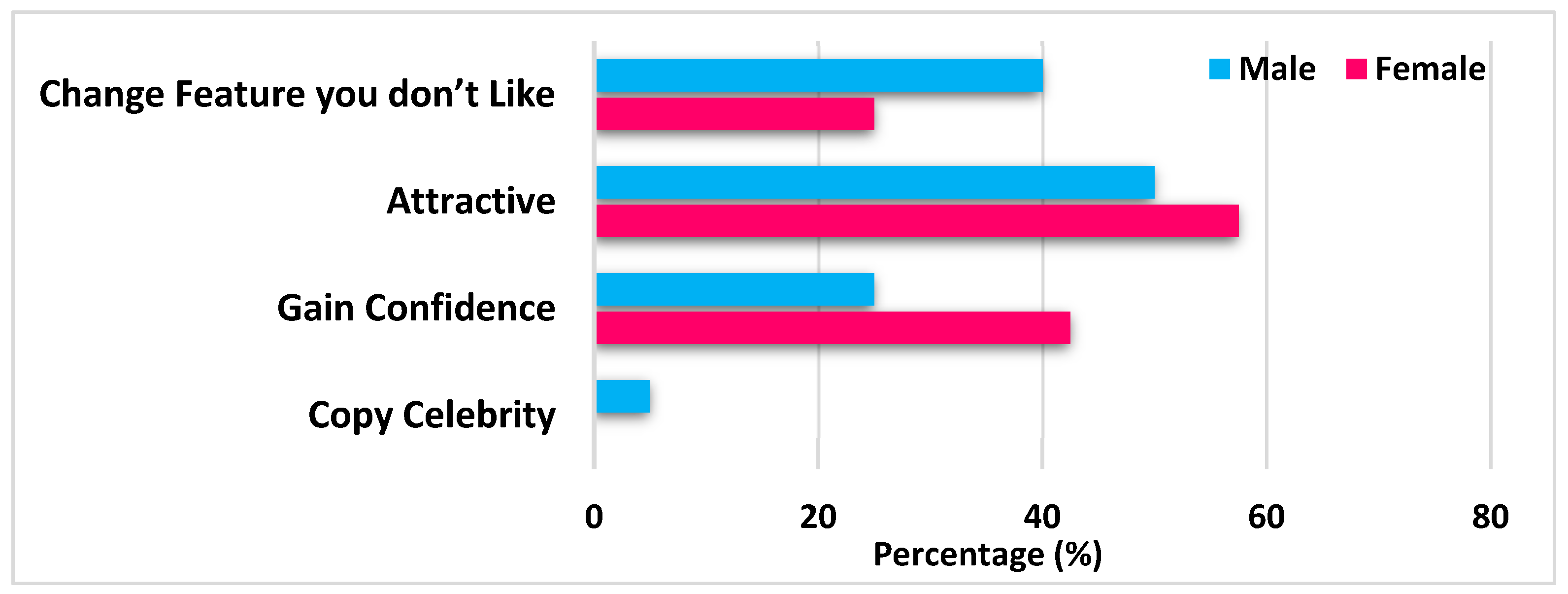

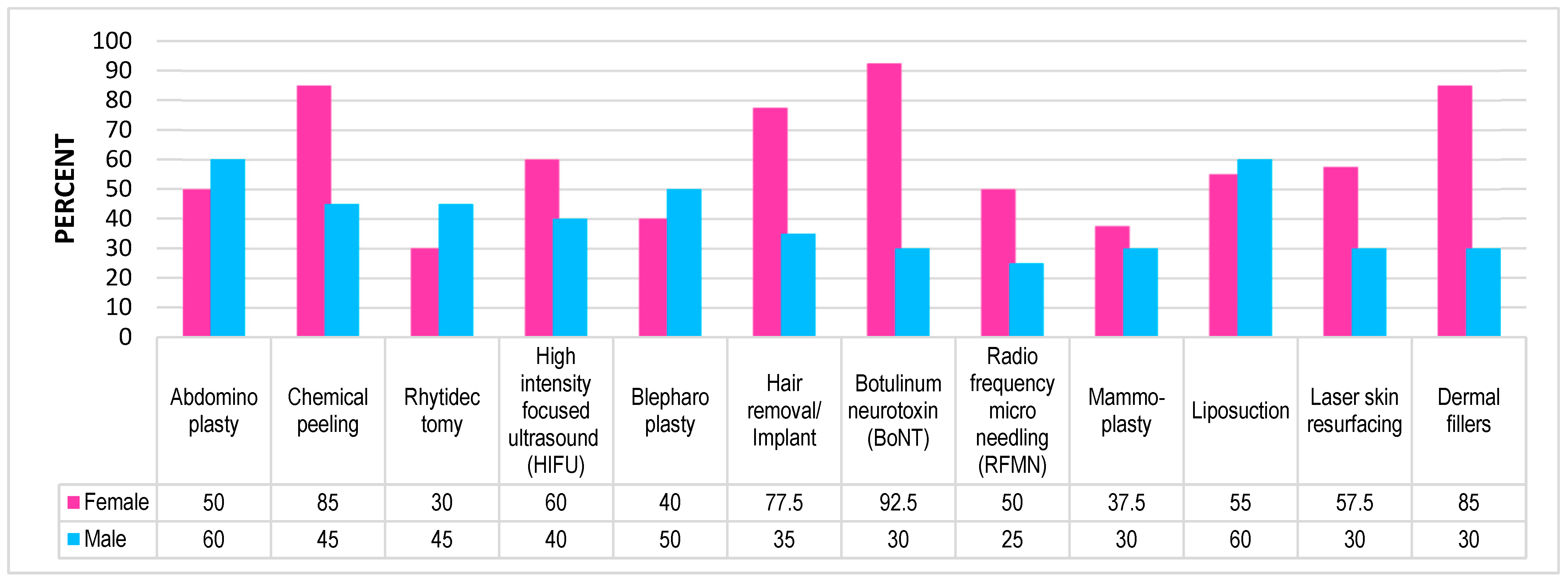
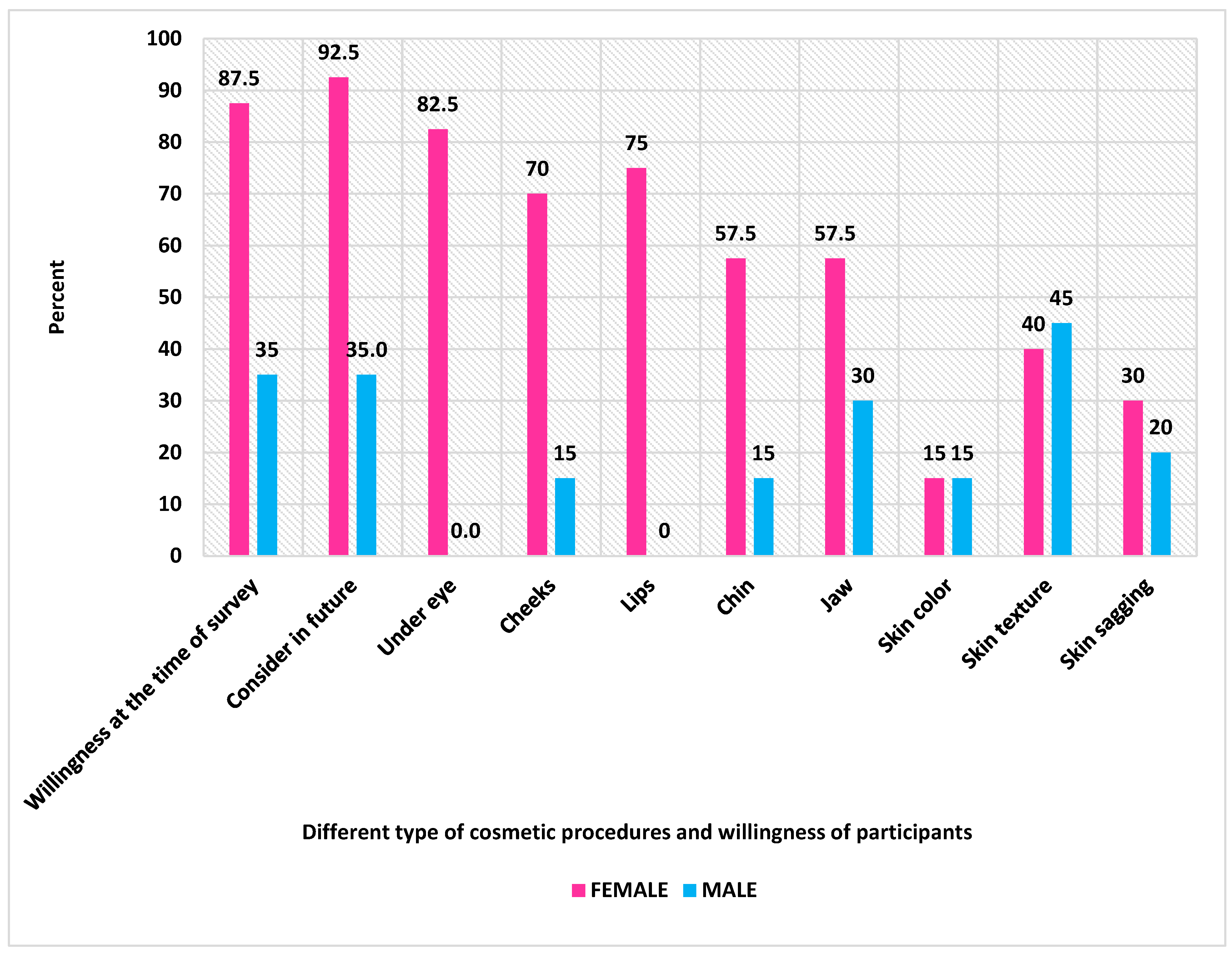
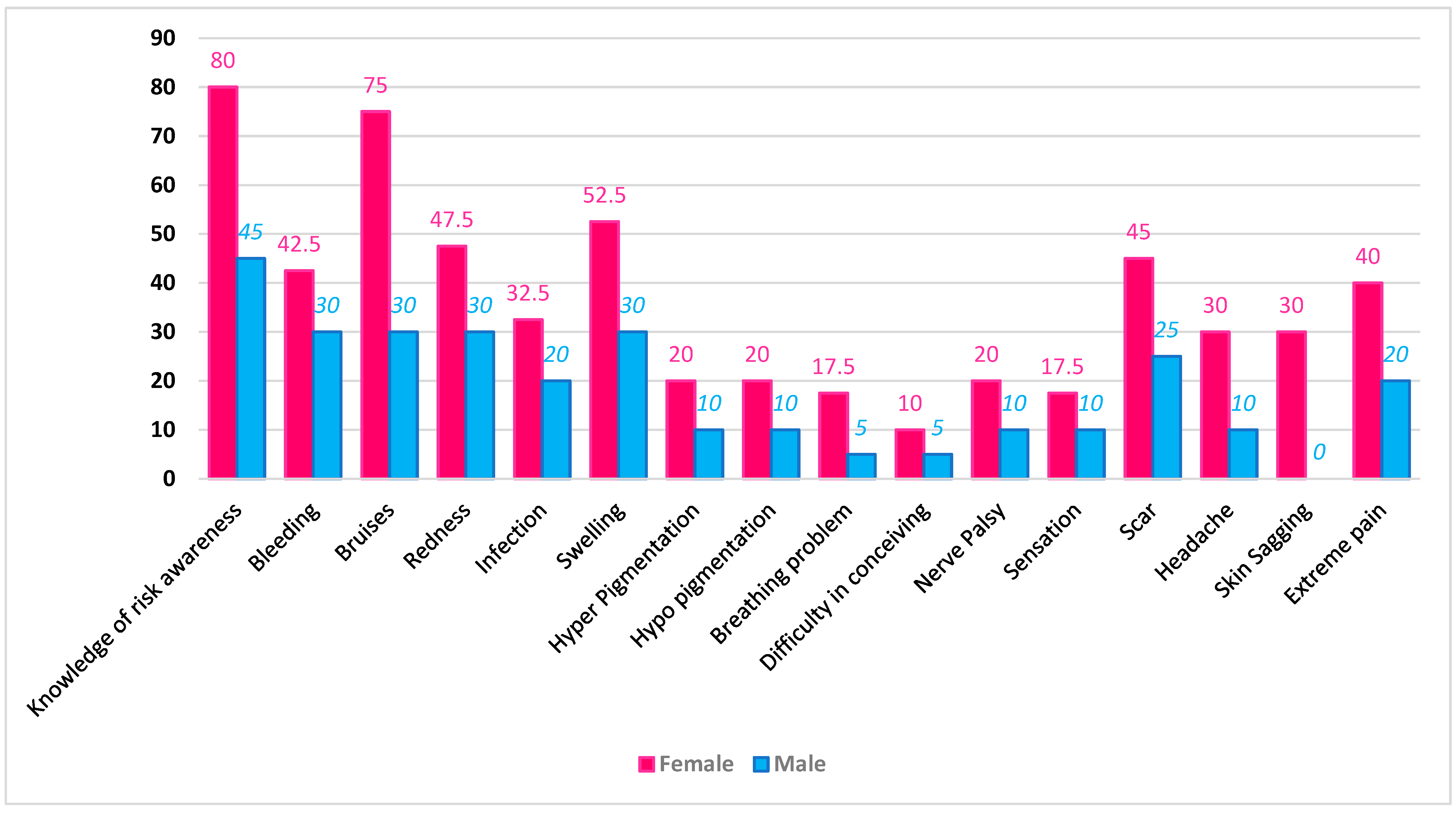

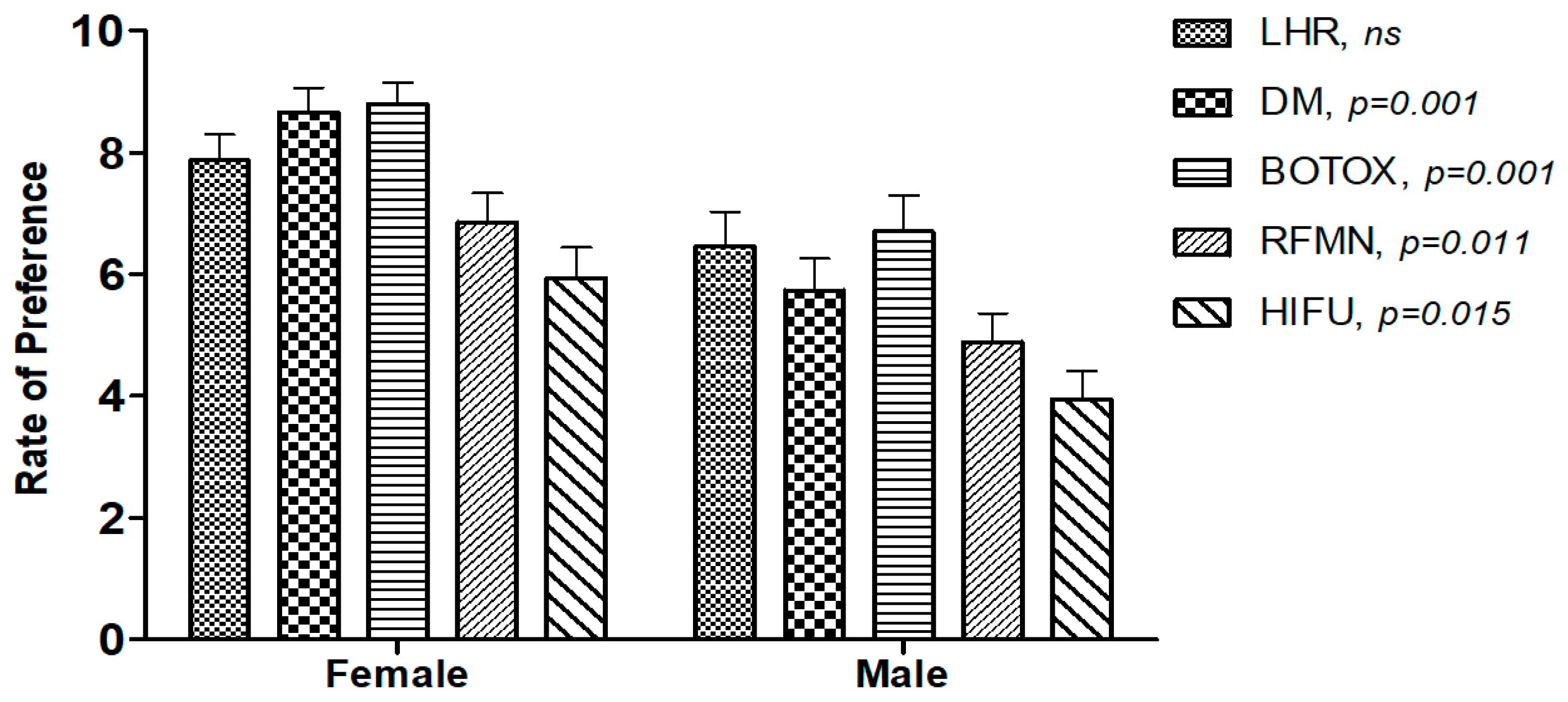
| Variable | Males (n = 20) | Females (n = 40) |
|---|---|---|
| Age (years) a | 27.0 [25.0–30.8] (19.0–60.0) | 30.5 [27.8–37.3] (21.0–58.0) |
| Marital status (%) (Single/Married/Divorced) | 65/35/0 | 40/45/15 |
| Physical activity (%) (Active/Sedentary) | 60/40 | 80/20 |
| Fitzpatrick skin type (%) (1/2/3/4/5/6) | 5/35/40/15/5/0% | 5/37.5/47.5/10/0/0% |
Disclaimer/Publisher’s Note: The statements, opinions and data contained in all publications are solely those of the individual author(s) and contributor(s) and not of MDPI and/or the editor(s). MDPI and/or the editor(s) disclaim responsibility for any injury to people or property resulting from any ideas, methods, instructions or products referred to in the content. |
© 2023 by the authors. Licensee MDPI, Basel, Switzerland. This article is an open access article distributed under the terms and conditions of the Creative Commons Attribution (CC BY) license (https://creativecommons.org/licenses/by/4.0/).
Share and Cite
Aladwan, S.M.; Shakya, A.K.; Naik, R.R.; Afrashtehfar, K.I. Awareness of Cosmetic Procedures among Adults Seeking to Enhance Their Physical Appearance: A Cross-Sectional Pilot Study in Central Jordan. Cosmetics 2023, 10, 19. https://doi.org/10.3390/cosmetics10010019
Aladwan SM, Shakya AK, Naik RR, Afrashtehfar KI. Awareness of Cosmetic Procedures among Adults Seeking to Enhance Their Physical Appearance: A Cross-Sectional Pilot Study in Central Jordan. Cosmetics. 2023; 10(1):19. https://doi.org/10.3390/cosmetics10010019
Chicago/Turabian StyleAladwan, Safwan M., Ashok K. Shakya, Rajashri R. Naik, and Kelvin I. Afrashtehfar. 2023. "Awareness of Cosmetic Procedures among Adults Seeking to Enhance Their Physical Appearance: A Cross-Sectional Pilot Study in Central Jordan" Cosmetics 10, no. 1: 19. https://doi.org/10.3390/cosmetics10010019
APA StyleAladwan, S. M., Shakya, A. K., Naik, R. R., & Afrashtehfar, K. I. (2023). Awareness of Cosmetic Procedures among Adults Seeking to Enhance Their Physical Appearance: A Cross-Sectional Pilot Study in Central Jordan. Cosmetics, 10(1), 19. https://doi.org/10.3390/cosmetics10010019










